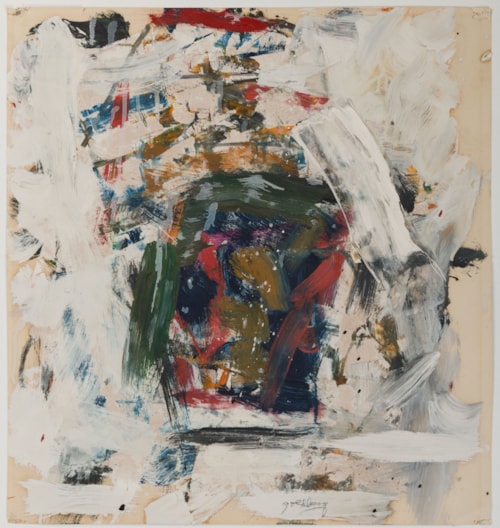
Michael GOLDBERG
New York 1924 - New York 2007
Biography
A second-generation Abstract Expressionist painter, Sylvan Irwin (known as Michael) Goldberg was born and raised in the Bronx in New York City and began attending Saturday classes at the Art Students League in Manhattan in 1938, at the age of fourteen. He also attended the school of the German-born painter and renowned art teacher Hans Hofmann, but his studies were interrupted by service in the Army during the Second World War, in the Pacific Theatre. After the war Goldberg continued studying with Hoffmann and at the League and, influenced by the work of such older painters as Franz Kline, Willem de Kooning and Clyfford Still, became a committed abstract expressionist artist. He frequented the Cedar Tavern in Greenwich Village, a popular meeting place for avant-garde artists and writers, and became friendly with many of the painters of the New York School. Goldberg first exhibited his work in public in the seminal Ninth Street Show of 1951, which was organized by a group of artists with the art dealer Leo Castelli, where his paintings were shown alongside those of De Kooning, Hoffman and Kline, as well as Jackson Pollock and the young Helen Frankenthaler. Two years later Goldberg had his first one-man exhibition at the Tibor de Nagy Gallery in New York. In 1955 he met the painter Norman Bluhm, through whom he was introduced to the collector Walter P. Chrysler, Jr. Chrysler visited Goldberg’s studio and eventually acquired several paintings by the artist for $10,000, and not long afterwards the artist began to be represented by the dealer Martha Jackson. From then on Goldberg’s work attracted considerable attention and acclaim.
From an early age Goldberg was an aficionado of New York’s jazz scene, and this lifelong passion for jazz music found its way into much of his art and the way he composed his pictures. Among his friends was the poet and museum curator Frank O’Hara, who dedicated several poems to the artist, and in 1960 the two collaborated on Odes, a book of poems and prints. In 1962 he took over Mark Rothko’s studio on the Bowery, on the Lower East Side of Manhattan. Both he and his wife, the artist Lynn Umlauf, taught at the School of Visual Arts in New York, and in the 1980s the couple began spending part of each year living in Tuscany. Goldberg never abandoned the manner of powerful, gestural painting, noting in a 2001 interview that, ‘For me, the concept of abstract painting is still the primary visual challenge of our time. It might get harder and harder to make an abstract image that’s believable, but I think that just makes the challenge greater.’
Works by Michael Goldberg are today in the collections of the Baltimore Museum of Art, the AKG Art Museum in Buffalo, the Art Institute of Chicago, the Museum of Fine Arts in Houston, the Walker Art Center in Minneapolis, the Museum of Modern Art, the Solomon R. Guggenheim Museum and the Whitney Museum of American Art in New York, the San Francisco Museum of Modern Art, the Hirshhorn Museum and Sculpture Garden and the Smithsonian American Art Museum in Washington, D.C., and elsewhere. In 2013-2014 the artist was the subject of a major museum retrospective exhibition, Abstraction over Time: The Paintings of Michael Goldberg, at the Museum of Contemporary Art in Jacksonville, Florida.


